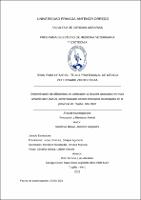| dc.contributor.advisor | Ortiz Tenorio, Luis Abraham | |
| dc.contributor.author | Sandoval Bravo, Jennifer Alejandra | |
| dc.creator | Sandoval Bravo, Jennifer Alejandra | |
| dc.date.accessioned | 2024-02-07T20:28:03Z | |
| dc.date.available | 2024-02-07T20:28:03Z | |
| dc.date.issued | 2024 | |
| dc.identifier.uri | https://hdl.handle.net/20.500.12759/20394 | |
| dc.description.abstract | Uno de los efectos directos y drásticos de la emergencia sanitaria de Covid19
es la disminución de la producción mundial de pollo en el Perú y el mundo, y que
para lograr la producción se hace uso obligado de dietas alimenticias
balanceadas, cuyo insumo energético de mayor uso es el maíz amarillo duro
(MAD), en el cual recae un permanente riesgo de contaminación fúngica por los
cambios climáticos y manejos, afectando su calidad organoléptica y nutricional,
repercutiendo en la sanidad y rendimiento productivo de las aves.
Esta investigación tuvo como objetivo la determinación de aflatoxinas en
correlación a factores asociados en maíz amarillo duro (MAD), comercializado
en tres mercados municipales en la provincia de Trujillo, región La Libertad. EL
estudio se llevó a cabo con treinta y seis muestras de 250 g. de maíz entero,
chancado y mediano, aplicando el test de flujo lateral, Symmetric Total Green 0-
30 que utiliza un buffer ecológico para el paso de extracción sin disolventes
orgánicos, registrando previamente la temperatura ambiente, temperatura de la
muestras, humedad, granulometría y condiciones del envase en el que se
expendía.
Obteniendo como resultado según el cálculo un índice de determinación del 3%
de aflatoxinas evidenciándose que se encontró aflatoxinas en el maíz amarillo
duro, mediante el test de flujo lateral. Así mismo, los factores asociados a la
presentación de aflatoxinas evaluados en el presente estudio indicaron mediante
la prueba de Fisher que no existe correlación p>0.05 entre las variables.
Concluyendo que existe presencia de aflatoxinas en maíz amarillo duro (MAD),
comercializado en tres mercados municipales en la provincia de Trujillo, región
La Libertad, en 3% de maíz perteneciente a la categoría de chancado.
Y que los factores asociados como temperatura ambiente, temperatura de la
muestra, humedad, granulometría y condiciones de envase no presentan
correlación con la presencia de aflatoxinas en las 36 muestras provenientes de
tres mercados municipales en la provincia de Trujillo | es_PE |
| dc.description.abstract | One of the direct and drastic effects of the Covid19 health emergency is the
decrease in global chicken production in Peru and the world, and that to achieve
production, balanced diets are required, the energy input of which is most
commonly used is hard yellow corn (HYC), in which there is a permanent risk of
fungal contamination due to climate changes and management, affecting its
organoleptic and nutritional quality, impacting the health and productive
performance of the birds.
This research aimed to determine aflatoxins in correlation to associated factors
in hard yellow corn (HYC), marketed in three municipal markets in the province
of Trujillo, La Libertad region. The study was carried out with thirty-six samples
of 250 g. of whole, crushed and medium corn, applying the lateral flow test,
Symmetric Total Green 0-30 that uses an ecological buffer for the extraction step
without organic solvents, previously recording the ambient temperature, sample
temperature, humidity, granulometry and conditions of the container in which it
was sold.
Obtaining as a result according to the calculation a determination index of 3% of
aflatoxins, showing that aflatoxins were found in the hard yellow corn, through the
lateral flow test. Likewise, the factors associated with the presentation of
aflatoxins evaluated in the present study indicated through the Fisher test that
there is no correlation p>0.05 between the variables.
Concluding that there is a presence of aflatoxins in hard yellow corn (HYC), sold
in three municipal markets in the province of Trujillo, La Libertad region, in 3% of
corn belonging to the crushed category.
And that the associated factors such as ambient temperature, sample
temperature, humidity, granulometry and packaging conditions did not present a
correlation with the presence of aflatoxins in the 36 samples from three municipal
markets in the province of Trujillo | es_PE |
| dc.description.uri | Tesis | es_PE |
| dc.format | application/pdf | es_PE |
| dc.language.iso | spa | es_PE |
| dc.publisher | Universidad Privada Antenor Orrego | es_PE |
| dc.relation.ispartofseries | T_VETE_190 | |
| dc.rights | info:eu-repo/semantics/closedAccess | es_PE |
| dc.rights.uri | https://creativecommons.org/licenses/by/4.0/ | es_PE |
| dc.source | Repositorio Institucional - UPAO | es_PE |
| dc.source | Universidad Privada Antenor Orrego | es_PE |
| dc.subject | Maiz Amarillo Duro | es_PE |
| dc.subject | Aflatoxinas | es_PE |
| dc.title | Determinación de aflatoxinas en correlación a factores asociados en maíz amarillo duro (MAD), comercializado en tres mercados municipales en la provincia de Trujillo, año 2023 | es_PE |
| dc.type | info:eu-repo/semantics/bachelorThesis | es_PE |
| thesis.degree.level | Título Profesional | es_PE |
| thesis.degree.grantor | Universidad Privada Antenor Orrego. Facultad de Ciencias Agrarias | es_PE |
| thesis.degree.name | Médico Veterinario Zootecnista | es_PE |
| thesis.degree.discipline | Medicina Veterinaria y Zootecnia | es_PE |
| dc.subject.ocde | https://purl.org/pe-repo/ocde/ford#4.03.00 | es_PE |
| renati.advisor.orcid | https://orcid.org/0000-0001-7990-814X | es_PE |
| renati.author.dni | 47019321 | |
| renati.advisor.dni | 27048968 | |
| renati.type | https://purl.org/pe-repo/renati/type#tesis | es_PE |
| renati.level | https://purl.org/pe-repo/renati/level#tituloProfesional | es_PE |
| renati.discipline | 841056 | es_PE |
| renati.juror | López Jiménez, Enrique Aguberto | |
| renati.juror | Mendoza Mendocilla, Roxana Marisce | |
| renati.juror | Zevallos Ochoa, Lizbeth Gissele | |
| dc.publisher.country | PE | es_PE |




